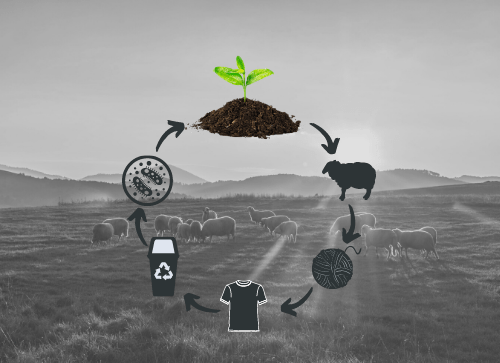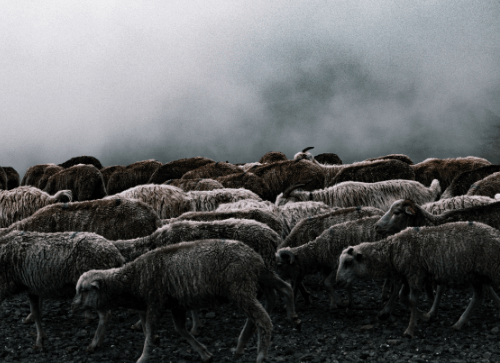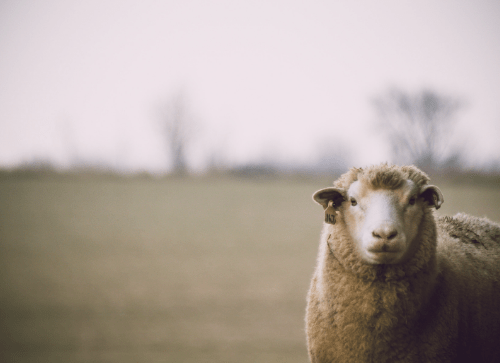The truth is, if you are rocking Merino wool apparel, you’re probably on board with saving the planet. Several Merino companies have committed millions of dollars toward environmental causes, and the eco-movement is synonymous with outdoor enthusiasts. But, to truly improve our planet’s health, we just can’t take a business’s word for their environmental practices – we have to find out for ourselves. Thus, we need to fully understand Merino wool sustainability methods.
At Merino Wool Gear, we like to take an objective approach from farm to fashion. We must dive into every aspect of Merino wool’s sustainability so that you can make up your mind for yourself as an informed consumer. We’ll outline Merino’s positive and negative environmental impacts and investigate what the industry is doing (and can do) to better protect the environment. Heck, we’ll even touch on what you can do as a Merino lover to be more sustainable.
Positive Environmental Impacts
Renewability
Any animal byproduct is renewable as long as the animal is sustainable within their environment. Merino sheep live off the land, eating grasses and drinking water within their habitat. When it comes time to be shorn (typically once a year), woolgrowers herd their sheep into a shearing shed. They then shave their fleece and release them back into their natural environment. The wool coat grows back throughout the year to protect the sheep from the weather; the farmer shears the sheep again. Ewes have babies, and the whole renewable (and ethical) woolgrowing process continues. It’s the circle of life!

Image from Merino Wool Gear Instagram
Merino sheep average 20 lbs of raw fleece – or greasy wool – per year (5 to 40 lbs depending on the bloodline). About half that weight is lost in sorting, cleaning, scouring, processing, and manufacturing. Considering a 12-year lifespan, one merino sheep can produce enough wool for over 100 garments over their lifetime (assuming ~1-lb per garment). It would take about 126 gallons of oil (3 barrels) to produce the same clothing amount. That same amount of oil could be used to fuel a midsize car for 840 miles!
Biodegradability
Unlike synthetic materials that take up precious space in landfills, Merino wool biodegrades back into the soil. Studies have shown that the wool will naturally degrade in about four months under normal conditions and even faster in warm and moist environments. As it is made up of keratin – the same protein found in human hair – microorganisms like bacteria and fungi feast on this protein down to its building blocks. Thus, emitting essential plant nutrients like nitrogen, magnesium, and sulfur back into the soil.
Many cultures have been using wool as garden fertilizer for centuries. A recent study has shown that shredded wool carpets sprinkled in the garden can increase crop yield by 400%.
But, that’s not where the positive benefits of wool’s biodegradability stop. As wool has excellent water retention properties, it reduces erosion by promoting more plant growth and better biodiversity when embedded in the soil. In fact, Merino degrades in marine environments, too! Therefore, it doesn’t contribute to our oceans’ ever-increasing pollution problem.
Carbon Cycle Assistance
As you probably already know, the more free carbon in the atmosphere, the worse the global warming effects. The only way to reduce the carbon level is through sequestration, primarily by plants. The plants remove the carbon; then the sheep eat the plants.
While this may seem like a normal process, wool in general has a much higher carbon makeup as compared to other fabrics. Approximately half of Merino wool comprises organic carbon, which is even higher than plant-based fabrics like cotton (40%). The global wool clip equates to nearly 2-million tons of trapped carbon, according to Tactical Distributors.
Less Washing It…
According to The Spruce, the average American Family does 8 – 10 loads of laundry per week at an average of 30 gallons per load. If you extrapolate that out annually, it’s nearly 15,000 gallons of water used per week, which is more water than a 24-ft above-ground pool!
Clean water is now a commodity. The excessive energy costs of laundry machines coupled with the millions of microplastics leaching into the waterways aren’t good for our oceans. It’s safe to say that washing your clothes less is much better for the environment.
One excellent quality about Merino wool is that it is naturally odor-resistant. The fibers themselves are hydrophilic, meaning it attracts waters and repels oils like the ones emitted from sweat-producing bacteria. In fact, we’ve done a smell test and worn the Ridge Merino Solstice Hoodie for 30-days straight (without deodorant), and it smelled just fine at month’s end. Also, by washing your clothes less, you’ll get a longer lifespan out of them, which we will get into next.
…More Wearing It
Did you know that the fashion industry makes up about 10% of global emissions? On top of that, nearly 85% of all fabric manufactured ends up in landfills. That’s insane! Therefore, the most significant sustainability factor of clothing is:
The longer you wear it, the better for the environment.
Think about it: the longer you wear your clothing, the less clothing you buy, and the less pollution from the entire farm-to-fashion process. In fact, a seven-year scientific study published in The International Journal of Life Cycle Assessment has proven this point. Wool garments thrown out after only 15 wears were responsible for nearly six times the amount of pollution than garments with just over 100-lifetime wears. On top of that, if the garment lifetime were to increase to 400-lifetime wears, it would reduce total emissions by 49 – 68%.
With Merino wool, you’ll be washing your garments less and getting more wears out of them with proper care. Thus, you’ll actually be reducing greenhouse gas emissions by merely wearing your clothes longer.
Negative Environmental Impacts
Livestock Emissions

Although we mentioned before that wool helps to sequester carbon from our atmosphere, Merino sheep also produce lots of methane, contributing to global warming. A study found that sheep release, on average, 4.9 kg of methane per year. In addition, it’s been shown that methane is 84-times more potent of a greenhouse gas than carbon dioxide.
There are 70-million sheep in Australia alone. These sheep combine for the equivalent of 28.8-million tonnes of CO2 (343,000metric tonnes of methane) released per year. According to the EPA, that’s the same greenhouse emissions per year as one-million homes’ energy consumption.
In New Zealand, it has been estimated that 90% of the nation’s greenhouse gas emissions come from sheep. In 2003, the government even proposed putting a hefty tax on sheep farmers. The Fart Tax – as it will forever be known – did not sit well with local farmers and thus withdrew from legislature.
Overgrazing

As Merino wool has grown in popularity, so has the total amount of sheep needed to keep up with demand. The more sheep grazing, the more land that is necessary. The traditional assumption is that farmers can sustain approximately five sheep per acre. If you consider the total usable pasture land in Australia, about 250-million sheep could be supported. As the total amount today is around 70-million, it seems that overgrazing isn’t an issue, right?
Well, not quite. Overgrazing does not merely mean the sheep are eating too many plants. It means they are overeating individual plants in certain areas leading to a lack of biodiversity. The natural variety of plants within a habitat provides a range of nutrients for the soil, keeping it viable for agriculture. When livestock like Merino spend too long in a particular area, they tend to increase the soil salinity and reduce biodiversity, causing soil erosion.
According to PETA, nearly 20% of the world’s pasture lands have been overgrazed and turned into badlands. In fact, Argentina’s Patagonia region used to be the second leading wool producer in the world. But as farmers tried to meet global wool demand with higher flock counts, the land was soon overgrazed.
It has been estimated that 93% of pastureland had been desertified. Today, Argentina is only the fifth-leading wool-producing country, with only 3% of the global market share.
While it may seem like Australia has its act together to reduce overgrazing, some damage has already been done. Although there is hope if farmers implement regenerative agriculture practices, we’ll get more into that in a bit.
Processing & Dyes
You may think that once the Merino wool garment-making process is simple: shear, spin, weave, and sew. That may be true if you are harvesting wool for yourself. However, the Merino wool industry uses more energy and resource-intensive processes.
After the wool gets carded and sorted, it needs to be scoured or washed to remove the grease, pesticides, and other organic matter (we are talking about poop) from the fleece. This process has been estimated to use approximately five cubic liters of water per kilogram of wool with additional potent cleaning agents. These chemicals and nasty organic materials may become suspended in the wastewater. If not treated properly, they could be reintroduced to the water supply.
Also, the process of dyeing the wool can lead to unwanted byproducts. Many industrial dyes in the wool industry include heavy metals like chrome. Again, when mishandled, they may leak into the water supply.
Most of today’s Merino is colored using natural dyes or even less harmful acidic substances. However, it’s still important to note that these options are typically more expensive, so smaller companies may opt for the less environmentally-friendly options to save money.
The Supply Chain
You may think you understand the farm-to-fashion process. However, there are so many steps within the supply chain that can lead to unwanted byproducts. There’s all the sorting of extra wool fleece. There’s the fabric that gets cutaway. Don’t forget about all the other leftover byproducts of production either.
In addition to much of the waste, Merino wool is a global fabric. For example, an Australian Merino’s fleece may be shipped to China to be scoured, Vietnam to be spun, Cambodia for garment-making, and finally across the Pacific to your doorstep. The fuel used in transporting the Merino is costly and not always conducive to its sustainable values.
What Are Merino Wool Companies Doing About Sustainability?
Sustainability is such a buzzword in today’s environmentally-friendly society. It seems that companies use terms like sustainable, green, eco-friendly, and others as a marketing ploy rather than the truth. But, there are a few companies and organizations out that genuinely commit to Merino wool sustainability. Let’s take a look at what brands are doing to ensure that Merino wool remains a sustainable, renewable resource.
Regenerative Farming

As we previously mentioned, livestock emissions and overgrazing can decimate an ecosystem. Sheep farmers can combat desertification by using regenerative agriculture. Here are just a few regenerative farming practices that woolgrowers are using:
- Planting native trees in pasturelands
- Rotational grazing (confining herds to specific areas and letting the local flora regrow before grazing again)
- Sequestering carbon via composting of sheep manure
- Improving biodiversity and soil health through pasture cropping
- Removing pollutants from waterways
- Using leaky weirs (natural barriers to sustain water levels)
In Australia, organizations like Greening Australia have been helping farmers implement these regenerative farming practices. Many Merino companies ensure that their suppliers are doing their best to preserve the land.
Improved Transparency
If you are a fan of eco-fashion, you probably want to know everything about the clothing manufacturing process. Unfortunately, many apparel companies hide some of their tactics as they aren’t always the most sustainable practices. But, there are a select few that put supply chain transparency to the forefront of their business. They understand that their consumers want the entire story behind their garments, not just the garment itself. It’s sort of like how we crave superhero origin stories, but instead of a radioactive spider, it’s a Merino sheep.
Companies like Icebreaker and Smartwool have publicly available transparency reports detailing every step of their process. When we mean detailing, we mean thirty solid pages of ripe consumer knowledge. Other companies are even tagging their fabric with NFC chips so customers can see exactly where in the world their clothing has been.
As companies offer a better understanding from farm to fashion, it empowers us to make better buying decisions. It instills trust and accountability for clothing brands. They must make better environmental decisions to appease their buyers. Because in the end, the Merino wool sustainability – or any product for that matter – ultimately comes down to us as consumers.
Industry Standards, Certifications, and Organizations
Implementing eco-friendly farming practices and streamlining the supply chain isn’t always enough. So, several wool industry standards and organizations have been put in place. These certifications ensure sustainable harvesting and manufacturing. Let’s take a closer look.
ZQ Merino
As one of the newer and more comprehensive certifications, New Zealand-based ZQ Merino focuses on the quality, sustainability, and ethics of Merino wool from farm to fashion. They have five core principles they abide by in each step of the wool process.
- Animal Welfare
- Environmental Sustainability
- Quality Fiber
- Traceable to Source
- Social Responsibility
To ensure that woolgrowers and clothing manufactures abide by their strict guidelines, ZQ performs random third-party audits on all of its members. Some of the more popular brands with a ZQ certification include Icebreaker, Smartwool, Allbirds, Glerups, Arc’Teryx, Mons Royale, Helly Hansen, and Fjallraven.
To learn more about the ZQ Merino certification, head over to their website or follow them on Instagram.
The Responsible Wool Standard (RWS)
The RWS is another all-encompassing wool certification that ensures all facilities and aspects of Merino production are held to the highest standards. They mention on their website that “RWS wool is maintained at all times: from the farm to the final product.” This includes everything from the farms, top makers, spinners, fabric mills, garment makers, and even the retailers themselves.
Learn more about the Responsible Wool Standard and the companies that are certified by them on their website.
Woolmark Certification
While not directly focused on sustainability, the Woolmark certification ensures that retailers use high-quality Merino wool. They run a series of five tests, mimicking real-world settings, to guarantee fabric performance and longevity.
- Wool Content: Merino fibers are microscopically assessed for authenticity.
- Color Retention: Merino clothing is exposed to heavy light for up to 10 hours to ensure coloring does not fade.
- Stress Analysis: Merino is stretched, pulled, twisted, and rolled to measure strength and durability.
- Laundry Testing: Wool clothing is put through a rigorous laundry cycle to test for shrinkage and shape loss.
- Liquid Immersion: Merino is submerged in various liquids that it may encounter in the real world, and fabric responses are observed.
Woolmark ensures that your Merino wool clothing is of the highest standard by conducting these scrupulous tests and will last you a long time. Thus, Woolmark does improve sustainability by assuring that your apparel will last longer.
Incorporation of Recycled Materials
Another way companies are helping our environment is through the utilization of recycled materials within Merino wool garments. As Merino is not as strong as synthetic, many clothing manufacturers use core-spun nylon or polyester to improve Merino durability. Many of these synthetics come from recycling and reclamation programs, allowing companies to utilize the already circulated resources rather than relying on new oil-based fabric.
In addition to synthetic recycling, several clothing manufacturers are using recycled wool products as well. For example, Smartwool has opened wool recycling facilities. They take all the scraps from their initial Merino production and reuse them in Smartloft insulation or deconstruct the fibers and use them in standalone garments. These pieces of recycled clothing perform the same as other pieces of Merino clothing.
If companies were to incorporate more recycled material into their clothing – in the grand scheme of sustainability – it would be less of a drain on our precious resources. For Merino, in particular, it would mean less reliance on fresh wool, leading to stabilized flock numbers. Methane emissions would slowly diminish, pasturelands would regenerate, and the ecosystem would stabilize. It’s almost a must that manufacturers use recycled materials to minimize Merino’s negative environmental impacts.
Giving Back To Charity
Last but not least, many Merino companies are pledging their support by donating to environmentally-friendly organizations. Ridge Merino and Bluey Merino even partake in a program called 1% for the Planet, which commits one percent of their profits to green non-profit organizations. Other companies are more focused on giving back to local community programs that focus on environmental education.
Obviously, money alone will not turn around our global crisis. But, it’s still a step in the right direction.
What Can You Do As The End User?
Ultimately, the sustainability of Merino wool comes down to you, the end-user. We know it’s a bit of a cop-out as corporations are doing most of the damage to our environment. But, your preferences and buying habits are what drive these businesses to sometimes cut corners. Therefore, it’s crucial to change your clothing consumption habits to make a difference. We can honestly make Merino the most environmentally-friendly fabric on the planet. Here a few tips to keep in mind:
Buy Less, Wash Less, Wear More
As we previously mentioned, the best way we can help the environment is by consuming less, doing less laundry, and increasing our clothing’s lifespan. We’ve had Merino clothing that has lasted us over a decade. It’s still holding firm.
Note: When you throw your Merino in the laundry, it’s essential to wash and dry it properly since the process is slightly different than other fabrics. We’ve put together a complete Merino wool care guide to ensure that you are getting the most out of your clothing. If you don’t have the time to read the entire piece, just follow the tag or label’s care instructions.
Know What You Are Buying, And From Whom
In today’s consumer world, knowledge is power. Don’t let supposed eco-friendly marketing gimmicks fool you. Do some research! The more you understand about each company and product, the more you can help the environment.
At Merino Wool Gear, we put together profiles on your favorite Merino wool companies. We have dedicated a specific section for each brand’s sustainability efforts. If you have a question about a particular brand or product not listed, feel free to reach out to us, and we’ll gather the pertinent information for you!
Don’t Throw Away Old Merino Clothing
If your Merino wool clothing does come to the end of its life, or you simply don’t want to wear it anymore, don’t throw it away; donate it! There are plenty of people (including us) that would love to pick up a Merino garment at the thrift store. If your clothing is not fit for resale for some reason, consider repurposing it into a cleaning rag, hand towel, or anything else. The more use we get out of any fabric, the healthier it is for the planet.
Companies like Minus33 have even put together Merino wool recycling programs that donate used clothing to search and rescue programs. Your old apparel will for sure be put to good use!
Support Or Donate What You Can
If you’ve got a bit of extra cash after you’ve purchased your Merino wool gear, consider putting that money to fair use by donating it. Not only will you feel good about yourself, but your money will help to save our planet, so you continue adventuring in a while rocking Merino.
Suppose you don’t have the extra cash, no problem! You can always help by donating your time to local charities that have an environmental focus. Check out the local charities near you and sign-up to help. They are always looking for volunteers!
Follow us on Instagram for more information about Merino wool sustainability, ethics, apparel, and everything in between! Or, sign-up for our newsletters containing deals, discounts, and more!

